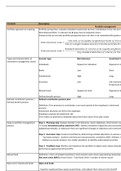Summary
Summary CFA LEVEL 1 - PORTFOLIO MANAGEMENT & WEALTH PLANNING
- Course
- Institution
- Book
I create this summary of knowledge related to CFA level 1 for my 2017 December exam. I got into the top 10% with this. Hope this can help you. (This does not guarantee for your pass, which requires dedication, hardwork and consistency. In case having trouble with any part, please refer to CFA note...
[Show more]



